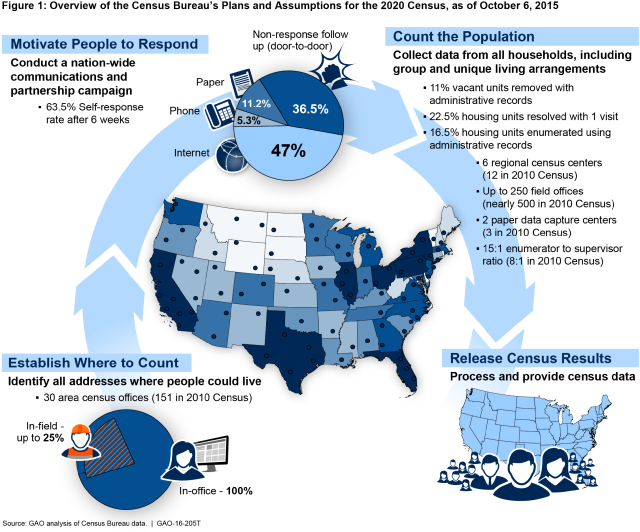Counting Down to the 2020 Census
It’s “Census Day” (no fooling)! April 1st is the traditional start date of the decennial census. So each April 1st, “Census Day,” gets the Census Bureau one year closer to launch. The stakes are high as the Census Bureau ramps up for the next decennial count: the 2010 Census cost about $13 billion from start to finish—the most expensive U.S. census in history. Today’s WatchBlog turns its attention to the Bureau to tally its progress toward the decennial Census.
Controlling costs
As we testified last April, the Census Bureau faces dual challenges of managing the costs of the 2020 Census without sacrificing accuracy. And, the Bureau is trying to rise to these management challenges. In October, the Bureau released its 2020 Census Operational Plan, which it estimates could help save $5.2 billion.
 (Excerpted from GAO-16-205T)
(Excerpted from GAO-16-205T)
The Bureau aims to save $2.5 billion by making better use of technology to change how it conducts field work. For example, the Bureau plans to manage temporary field workers remotely, greatly reducing the number of supervisors it needs to hire. The Bureau tested this and other changes last year and was generally successful.
In addition, the Bureau believes it could save as much as $1.4 billion by relying more heavily on administrative records—public records that hold some of the information the Bureau is trying to collect. Although administrative records have been used for the decennial census since the 1970s, the Bureau plans a more significant role for them in 2020. For example, the Bureau plans to use these records to help identify which houses are vacant, reducing how many times field workers must visit a place to confirm it’s unoccupied.
Keeping tabs
While the Census Bureau is making progress identifying ways to save money, we’ve been watching their efforts, checking their work, and recommending ways to improve. For example, while it’s great that the Bureau has all of these ideas for saving money, they need to know when to stop researching less-promising ideas, to focus resources on refining and executing the ones with the most potential. And some of these decisions need to be made soon, such as whether the Bureau will build or buy some of the new IT systems it needs to realize some of its savings.
Follow us on this decade-long audit trail by checking out all of our open recommendations to the Bureau.
Comments on GAO’s WatchBlog? Contact blog@gao.gov.





